Hindu Gods and Goddesses of Yoga
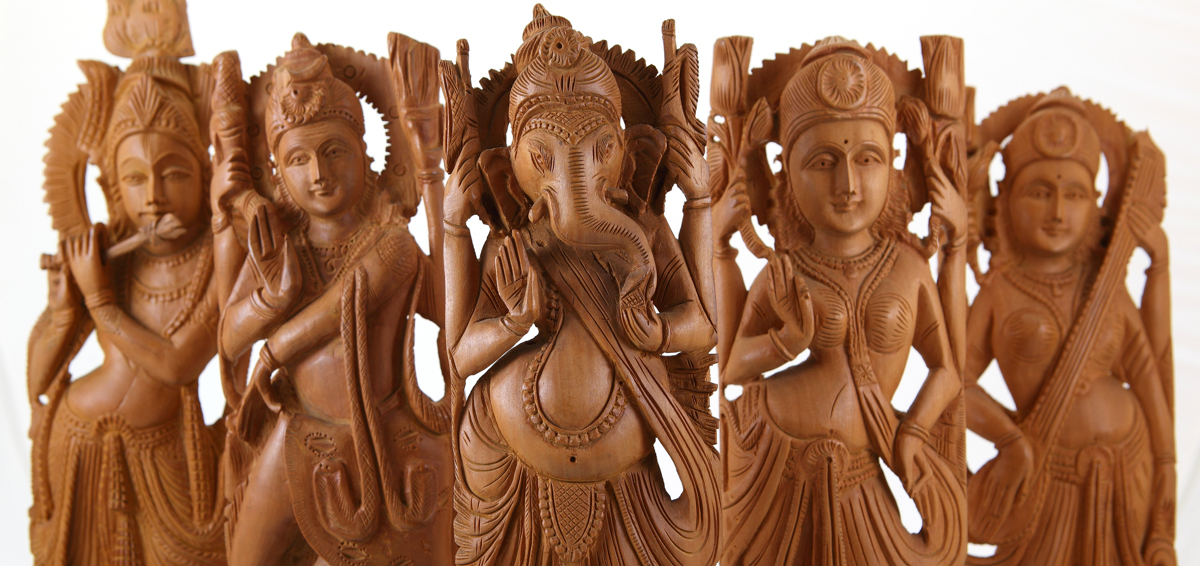
Hinduism is an amalgam of various beliefs, rituals, concepts and traditions that are expressed through imaginative mythological characters. There are countless deities, devatas, incarnations and avatars in this fascinating religion, and many are associated with yogic philosophies, doctrines and techniques. These Hindu gods and goddesses of yoga are symbols of spiritual concepts; they are representations of various powers of nature. Fundamentally, their stories provide invaluable guidance along the yogic path to realizing our full potential.
“The whole edifice of Indian civilization is imbued with spiritual meaning. The close interdependence and perfect harmonization of the two serve to counteract the natural tendency of Indian philosophy to become recondite and esoteric, removed from life and the task of the education of society. In the Hindu world, the folklore and popular mythology carry the truths and teachings of the philosophers to the masses. In this symbolic form the ideas do not have to be watered down to be popularized. The vivid, perfectly appropriate pictorial script preserves the doctrines without the slightest damage to their sense.”
— Heinrich Zimmer, German Indologist
It’s common to see Hindu deities with one hand in Abhaya Mudra for fearlessness (an outfacing palm with the fingers pointing upwards); and another hand in Varada Mudra to show generosity (an outfacing palm with the fingers pointed downwards). Also, every god or goddess is normally depicted with certain colours, physical traits, attributes, animals and surroundings. Each one of these features, no matter how inconspicuous, is a subtle analogy for a much deeper metaphysical meaning.
The gods and goddesses described below are the ones that are most customarily heard in yogic chants, ancient scriptures and Sanskrit mantras.
Saraswati
“Only ‘knowledge’ can help us to know the universe, which is vast like an ocean. It enlightens all minds.”
— The Rig Veda
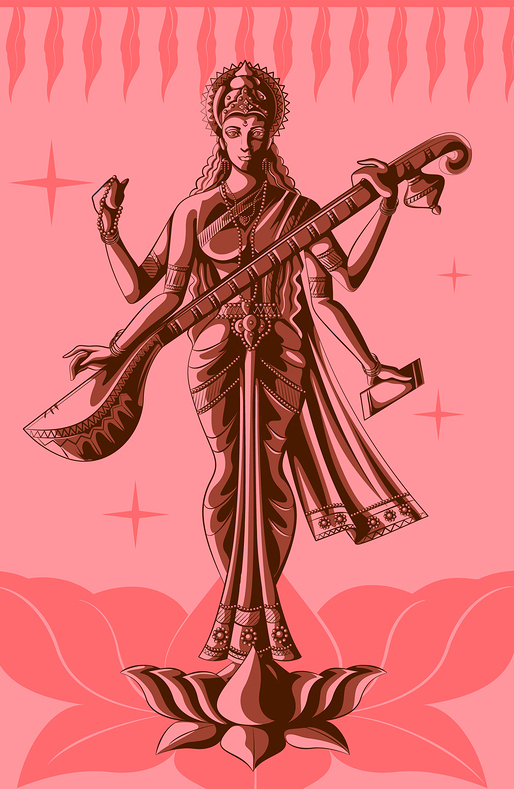
The goddess of knowledge, creativity, intuition, wisdom and eloquence is Saraswati. Together with Lakshmi and Parvati, she forms the Trinity of supreme Goddesses in Hinduism. Her consort is Brahma, the creator of the universe. She is also a divine figure in Jainism and Buddhism.
Saraswati is usually depicted in pure white, which represents enlightenment, truth and knowledge. She wears a frosted white sari, sits or stands in a white lotus and is sometimes accompanied by a white swan or peacock. Generally, she has four arms which hold a book for learning and knowledge; a pot of water for the power of reasoning; mala beads for meditation and thought; and most prominently, a veena (an Indian musical instrument) for creativity and harmony.
Knowledge and creativity is godly. It is knowledge that eradicates ignorance and leads to one of the ultimate goals of yoga: the fulfillment of one’s own potential. And it is through the power of creative thought, intuition, reasoning and intellect that we move closer to our highest selves. When we call upon Saraswati during the opening prayers at the start of each yogic practice, we are extinguishing ignorance, mediocrity and darkness from our minds, thus opening ourselves up to divine self improvement.
Vishnu
“If we pray the God Narayana,
Having with him the scented garland,
Made of holy basil,
He would give us gifts, many.”
— Andal, Tamil Poet-Saint
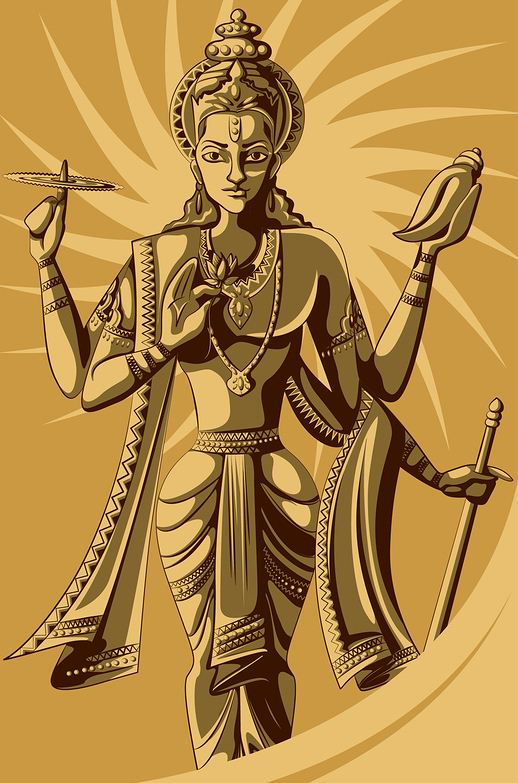
Vishnu the Preserver is the second in the Trinity of Hindu Gods, that also includes Brahma and Shiva. As Brahma’s role is to create the universe, it is Vishnu’s duty to preserve, maintain and protect it. Sometimes referred to as the God of Peace, Narayana or Hari, he is the all-pervasive deity that restores balance and brings back order in times of trouble.
Vishnu is ordinarily characterized in the form of a human with blue skin and four arms. At times, he is pictured lying on a serpent or riding an eagle. In his four hands, he holds a conch that represents creation; a lotus for purity; a chakra that symbolizes control of the mind; and a mace for strength and power.
The Vishnu mantra “Om Namo Narayanaya” is frequently used in various yogic traditions, particularly Sivananda Yoga, to radiate vibrations of peace and harmony in the mind, body and spirit.
Lakshmi
“It sometimes strikes me how immensely fortunate I am that each day should take its place in my life, either reddened with the rising and setting sun, or refreshingly cool with deep, dark clouds, or blooming like a white flower in the moonlight. What untold wealth!”
— Rabindranath Tagore, Indian Poet
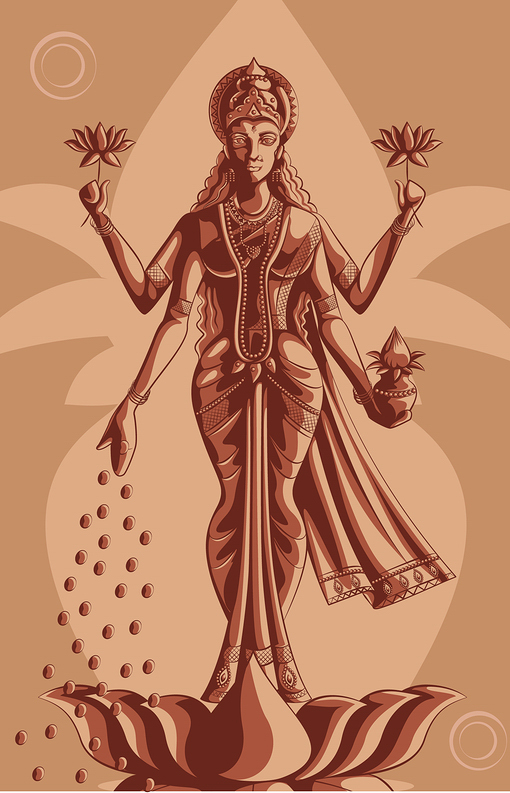
Lakshmi, Vishnu’s companion, is the goddess of prosperity, abundance, wealth, fertility and fortune. Like Saraswati, she is part of the Trinity of Goddesses. Widely venerated throughout the Indian subcontinent and Southeast Asia, she is a cherished deity in Hinduism, Jainism and Buddhism.
Customarily dressed in a red or gold-embroidered sari, Lakshmi sits or stands in a fully bloomed lotus and also holds lotuses in her hands to personify purity. Typically, fountains of gold coins stream from her palms and pots of gold are at her side. Her four arms embody the four goals of human existence: righteousness (dharma), love (kama), wealth (artha) and liberation (moksha). She is sometimes depicted with two elephants for strength and an owl for spiritual insight.
Wealth is usually associated with money. But Lakshmi epitomizes true wealth in yogic tradition, which is much more than just material things. It also means thriving relationships, bountiful health and happiness, abundant knowledge, strong moral principles and prosperity of spirit.
Rama
“Rama at once invoked a weapon called ‘Gnana,’ which means ‘wisdom’ or ‘perception.’ And all the terrifying armies who seemed to have come on in such a great mass suddenly evaporated into thin air.”
— The Ramayana
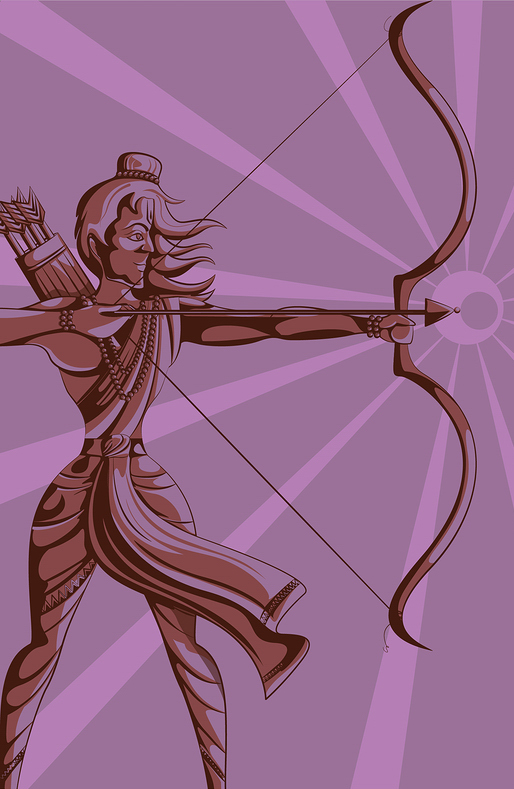
Vishnu’s seventh reincarnation was as Rama: a hero, warrior king and epitome of steadfast ethics, dedication, moderation and adherence to duty. As a matter of fact, Rama personifies the very concept of dharma that every spiritual seeker aims to live by. He is a revered deity in Hinduism, Jainism, Buddhism and Sikhism.
He is also known for being the main protagonist in the epic Sanskrit tale, Ramayana, in which he rescues his wife Sita from the evil demon, Rāvana. There are many versions of how the story ends, but ultimately, he is recognized for his resolute desire to do the right thing.
Rama is usually blue-skinned, dressed in yellow or orange robes and holds a bow and arrow. In many illustrations, he is seen together with Sita and his faithful follower, Hanuman.
When “Haré Rāma” or “Jaya Rām” is chanted in yogic traditions, what is praised and called into existence within ourselves is the unwavering adherence to right living.
Hanuman
“When I do not know who I am, I serve You; and when I do know who I am, You and I are One.”
— Hanuman, The Shrī Rāmcharitmānas
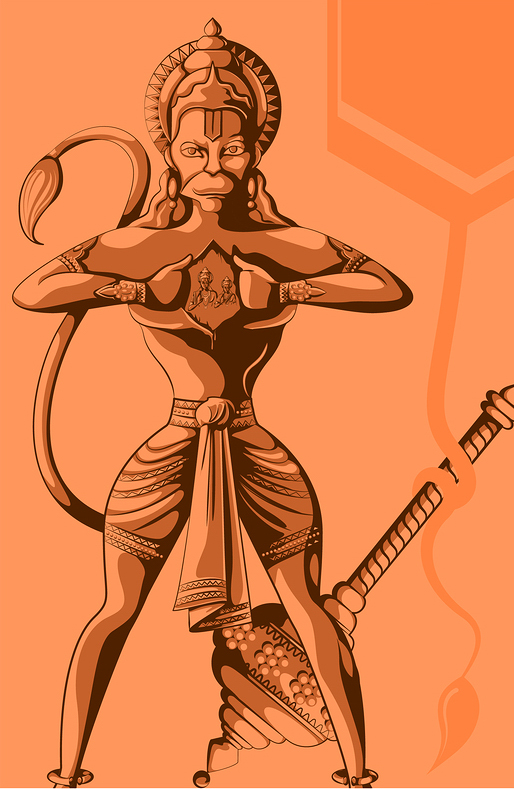
In addition to being a legendary character in many cultures and religions throughout the Asian continent, Hanuman is Rama’s trusted army general and most loyal devotee in the literary fable, Ramayana. He is the personification of physical competence, strength, speed, agility and energy. He also represents the spiritual virtues of faith, courage, devotion and humility.
As half-man, half-monkey, Hanuman is occasionally called Anjaneya and is the son of the monkey queen and the Lord of the Winds. He is considered to be a demigod and is most commonly portrayed with Rama and Sita. When shown alone, he is depicted in a very heroic pose or even flying through the air with a mace, a bolt of thunder or a mountain. Sometimes, he is pictured opening up his chest to show the purity and devotion of his heart.
Hanuman is the inspirational spirit for Karma yogis because he represents hard work and selfless service through right intention and a humble heart. The yogic posture, Hanumanasana, derives from the fable of Hanuman’s courage and dedication when he leapt across the sea to help Rama rescue Sita.
Krishna
“Just as a lamp in a windless place does not flicker, so the disciplined mind of a yogi remains steady in meditation on the self.”
— Krishna, The Bhagavad Gita
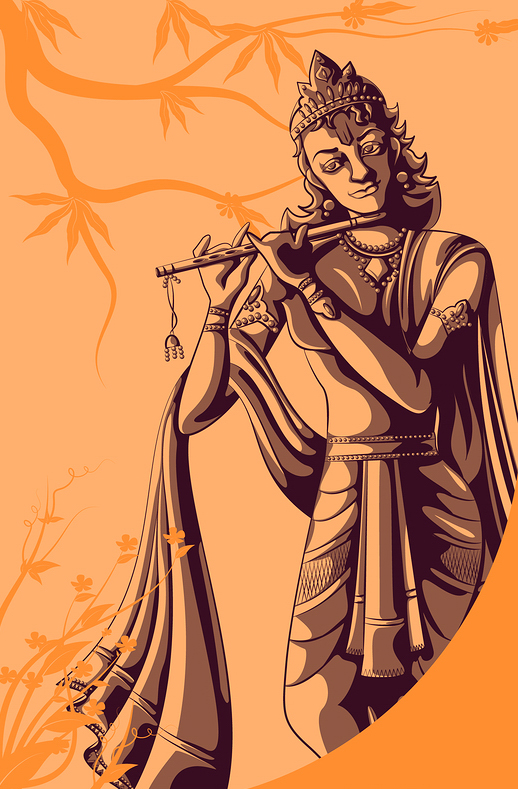
When Vishnu was reincarnated an eighth time, he appeared as Krishna, the god of love, joy and compassion. As a child, Krishna was playful, mischievous and known to adoringly steal butter from his friends and neighbours. In his youth, he became a cowherd, charming all the milkmaids, or gopis, with the music of his flute. Subsequently, he was sometimes called Gopala (the protector of cows) or Govinda (the herdsman).
With blue skin, a yellow robe and a crown of peacock feathers, Krishna is habitually pictured playing the flute in a dance-like stance. At times, he is accompanied by cows, surrounded by smitten milkmaids or coupled with his partner, Radha (a corresponding manifestation of Lakshmi).
In the texts, Krishna grows up to be a just and fair defender of his community and eventually becomes a charioteer in the fictional Mahabharata War. The Bhagavad Gita, a Hindu scripture which forms the backbone of yogic philosophy, is based upon the teachings of yoga which Krishna conveys to Prince Arjuna on the battlefield. So when we chant “Haré Krishna,” we are in effect, calling upon a higher level of consciousness and spiritual energy.
Shiva
“Fire is his head, the sun and moon his eyes, space his ears, the Vedas his speech, the wind his breath, the universe his heart. From his feet the Earth has originated. Verily, he is the inner self of all beings.”
— The Upanishads
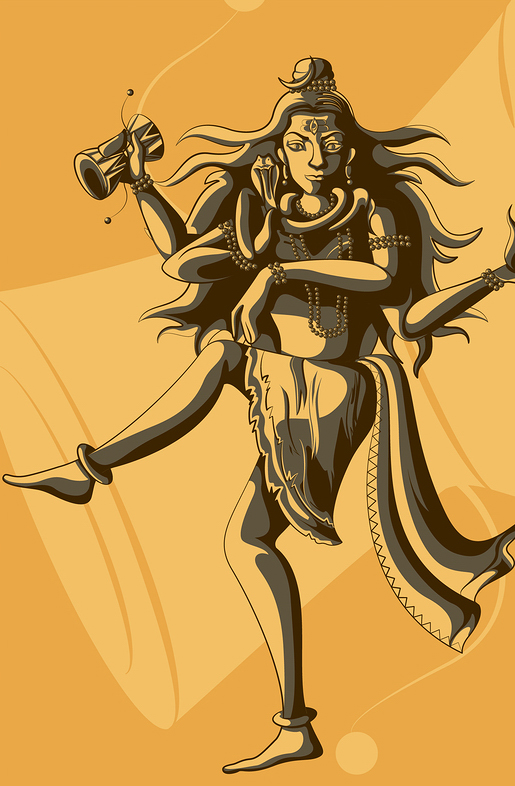
Shiva the Destroyer is the patron god of yoga, meditation, music, art and dance. He is the third in the Trinity of Hindu Gods and is prominent in numerous Asian cultures and religions. As Brahma creates the universe and Vishnu preserves it, Shiva’s role is to destroy and recreate. This isn’t a negative destruction, but rather a constructive one. It is the crushing of illusions, shortcomings and ignorance to make way for something new, evolved and better.
Although many interpretations regard him as genderless, Shiva is usually depicted as a man. He has a blue face and throat; a third eye representing wisdom (which the Mahā Mrityunjaya refers to); and long hair from which the River Ganges flows. A serpent coiled around his neck, a three-pronged trident and a bull are some of his distinctive attributes.
The yoga pose, Natarajasana, is based upon one of Shiva’s most well known forms: Nataraja. In fact, Shiva is considered to be one of the origins of the entire concept of yoga and meditation. The philosophy, science and techniques that are articulated in many Hindu texts are actually represented by him. Consequently, he is called the Lord of Yogis, the Adi Guru (the First Teacher) and the Mahayogi (the Great Ascetic). His very energy symbolizes continuous improvement and self-expression. When “Om Namah Shivaya” is recited, we are essentially recognizing and honouring our own divine higher selves.
Durga
“Thou art Durga, Lady and Queen,
With her hands that strike and her swords of sheen.”
— Bankim Chandra Chatterjee, Indian Writer
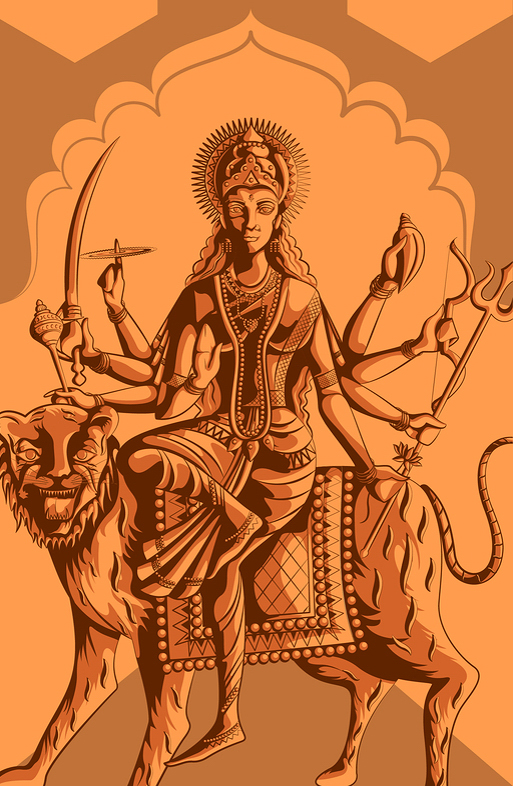
Durga is the invincible and fearless warrior goddess who battles the forces of evil and protects the world from suffering, disaster, hatred, corruption and wrongdoing. As Shiva’s consort, she complements his persona of destruction, but in a much more forceful and dramatic way. She is also an avatar of Parvati, who completes the Trinity of Hindu Goddesses. Her energy is so mighty that she is revered by all other gods and known as Devi (The Goddess) or Shakti (The Power). Actually, some ancient scriptures regard her to be the supreme being and the creator of the entire universe.
With between eight and eighteen arms, each holding various symbolic weapons, Durga frequently appears riding on a lion or a tiger and boldly slaying a demon buffalo. Like Shiva, she has three eyes which represent desire, action and knowledge. She is depicted as terrifying, aggressive and fierce; but a serene expression on her face indicates that ultimately, she fights for good over evil.
In the opening prayers of yogic practice, Durga is referred to as “Tryambake” (the 3-eyed goddess). She expresses the act of consciously, courageously and assertively overcoming our own unhealthy thoughts, negative feelings and bad intentions.
Ganesha
“Oh divine knowledge, beautiful beyond word,
who came as wish-fulfilling elephant, we heard.
Oh mouse-rider, fond of the three famed fruit,
desire to make me yours this instant, takes root.”
— Avvaiyar, Tamil Poetess
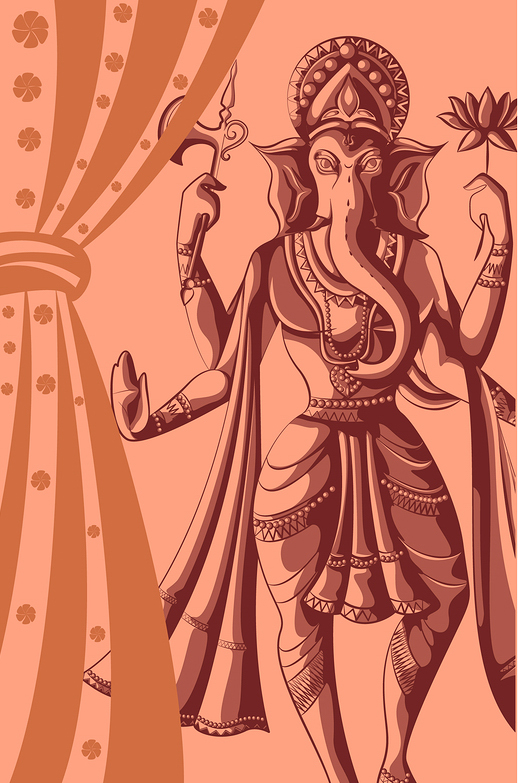
Last, but certainly not least, is Ganesha, one of the most recognized, popular and adored deities in Hinduism, Jainism and Buddhism. Legend has it that he was actually born as a regular human to Shiva and Parvati. But when Ganesha was a little boy, Shiva mistakenly cut off his head. To fix this tragic error and to avoid the wrath of Parvati, he replaced his son’s lost head with the head of the nearest animal he could find: an elephant.
Blessed by the elephant’s majestic qualities of intelligence, strength, nobility, wisdom and empathy, Ganesha became the Lord of all Beings. He was honoured with several other titles such as Ganapati, Vināyaka, Vigneshvara, and Gajānana. As the Remover of Obstacles, he is the first to be called upon for success in new endeavours, journeys and projects. He is also the patron god of learning, arts, sciences and letter-writing.
Due to his fondness for sweets and desserts, Ganesha is customarily depicted as a large figure with a cheerful disposition. His four hands hold a lotus for purity and perfection; a noose that symbolizes attachment to material things; an axe to destroy these attachments; and a ball of sweet rice that represents the rewards of leading a spiritual life. One full tusk and one broken tusk indicate that perfection and imperfection are both part of the Self. And usually seen near his feet is a mouse, which signifies controlled desire.
In the Sivananda tradition, Ganesha is the first to be invoked and celebrated during opening prayers, the chanting of Jaya Ganesha and Arati. He is equally hailed in all other schools and lineages of yoga because he personifies divine wisdom, mastery of the ego and remarkable discipline of desires.

In conclusion, these gods and goddesses are not only important divinities in Hinduism, but also in the other religions that are connected to Yoga, such as Buddhism, Sikhism and Jainism. Their importance extends to the cultures and traditions of not only India, but several other nations such as Sri Lanka, Cambodia, Thailand, Indonesia (particularly Bali and Java), Malaysia, Singapore, Nepal, Tibet, Vietnam, Borneo, Myanmar and even Japan.
Knowing and understanding what these deities are and what they exemplify is a fundamental part of knowing and understanding Yoga itself.

Very cool post! I had only heard of Ganesha, Shiva, and Krishna… So much history behind these gods and goddesses! Thank you for posting and great pics! Nice layout to your site!
Thanks Eric!
Wow! I’ve been practicing yoga for years and I’ve learned more in this article then I have in the last five years of my practice. I wish you lived closer to me so you could be my instructor.
Great article. I’ll be back for more!
Glad you found it useful!
Thanks for the great article! I’ve certainly heard about many of these Hindu gods and goddesses during my visits to Bali. I love the culture there and how religious the people are. I’ve always been intrigued by yoga too, it is on my to-do list, I really hope to get started on it one day.
I used to teach yoga in Bali, and yes I agree, Hinduism is definitely a prominent part of Balinese culture. No wonder that it’s a haven for spiritual practice!
All the best with your own!
This is a great article. Even though I am familiar with the gods and goddesses from a TV screen, you now make me feel them. Thank you so much. I only knew about Krishna from the best movie of the Indian actor Hrithik Roshan acting as Krishna in the movie Krish.
Never seen it! But thanks for the suggestion!
I have always liked mythology and I’ve learned about the different religions that exist in the world. India is a country with a very rich culture and incredible places. And there is yoga, which does very well for the body and mind. Great post.
Very true… Thanks Roberto!